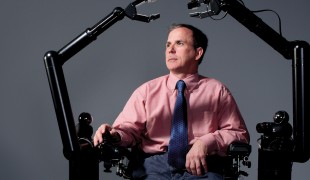- 6198
- 375
- 16
- 11
- 0
- Help Ukraine
About the solution
When they were about to become parents, Christina Mills and her husband had a hard time finding a baby crib that would fit their needs. Christina and her husband are both short stature and Christina uses a wheelchair so it would be very hard for them to use a common crib, with high frames that requires babies to be picked up and put down from a height. Searching the market, they found only one product that could be a good fit but it was overpriced and they couldn’t afford it.
So, they had to come up with their own solution. The couple bought a regular crib and figured out how they could adapt it but turning one of the side-frames of the crib into a door. They sawed the side in half and re-attached the pieces to the head and foot section of the crib using piano hinges. Then, they secured the two pieces by adding two locks in the middle. This way, they can open the side of the crib like French doors, having direct access to baby at the level of the
mattress, being able to pick her up with having to lift her over the frame.
More information: http://atnetworkblog.blogspot.com/2012/08/creating-accessible-crib-for-p...
This solution shall not include mention to the use of drugs, chemicals or biologicals (including food); invasive devices; offensive, commercial or inherently dangerous content. This solution was not medically validated. Proceed with caution! If you have any doubts, please consult with a health professional.
DISCLAIMER: This story was written by someone who is not the author of the solution, therefore please be advised that, although it was written with the utmost respect for the innovation and the innovator, there can be some incorrect statements. If you find any errors please contact the patient Innovation team via info@patient-innovation.com
-
-
377
-
0
-
5496

Find the ALS clinical trial that's right for you with ease and confidence.
CAREGIVING
Amyotrophic Lateral Sclerosis
Website
Promoting self-management
Building Supportive Community Relationships
Promoting inclusivity and social integration
Preventing (Vaccination, Protection, Falls, Research/Mapping)
Raise awareness
Caregiving Support
Clinical Pathology
Clinical Pharmacology
General and Family Medicine
Internal Medicine
Medical Genetics
Neurology
Orthopedics
Physical Medicine and Rehabilitation
Rheumatology
United States
-
-
-
281
-
0
-
3295

Teacher Alex Truesdell is Transforming Lives: Adaptive Design Association Revolutionizes Disability Solutions
CAREGIVING
Drawing
Painting
Playing
BODY BALANCE: Maintaining body balance
(SELF)-CARE: DRINKING: Drinking independently.
(SELF)-CARE: EATING: Eating independently.
MOVING IN A WHEELCHAIR: Moving using a wheelchair.
Playing an instrument
Studying
Blindness
Hand Deformity
Neuromuscular Disorders
Assistive Daily Life Device (to help ADL)
Walking Aid (wheelchair/walker/crutches)
Restoring mobility
Replacing lost limbs
Enhancing health literacy
Promoting self-management
Promoting inclusivity and social integration
To improve Treatment/Therapy
Preventing (Vaccination, Protection, Falls, Research/Mapping)
Raise awareness
Caregiving Support
General and Family Medicine
Internal Medicine
Orthopedics
Pediatrics
Physical Medicine and Rehabilitation
United States
-
-
-
447
-
0
-
7229

Paralyzed man designs innovative wheelchairs
CAREGIVING
MOVING IN A WHEELCHAIR: Moving using a wheelchair.
Grip
Rubgy
Basketball
Paralysis
Cervical spinal cord injury/Tetraplegia
Assistive Daily Life Device (to help ADL)
Assistive Technology access
Walking Aid (wheelchair/walker/crutches)
Restoring mobility
Replacing lost limbs
Promoting self-management
Promoting inclusivity and social integration
Recovering from Traumatic Injuries
Preventing (Vaccination, Protection, Falls, Research/Mapping)
Caregiving Support
Neurology
Orthopedics
Physical Medicine and Rehabilitation
United States
-
 en
en